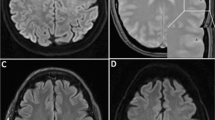Abstract
Our purpose was to investigate nonhaemorrhagic infarcts with a short T1 in the cerebellum and basal ganglia. We carried out repeat MRI on 12 patients with infarcts in the cerebellum or basal ganglia with a short T1. Cerebellar cortical lesions showed high signal on T1-weighted spin-echo images beginning at 2 weeks, which became prominent from 3 weeks to 2 months, and persisted for as long as 14 months after the ictus. The basal ganglia lesions demonstrated slightly high signal from a week after the ictus, which became more intense thereafter. Signal intensity began to fade gradually after 2 months. High signal could be seen at the periphery until 5 months, and then disappeared, while low or isointense signal, seen in the central portion from day 20, persisted thereafter.
Similar content being viewed by others
Author information
Authors and Affiliations
Additional information
Received: 1 February 1999 Accepted: 13 September 1999
Rights and permissions
About this article
Cite this article
Komiyama, M., Nakajima, H., Nishikawa, M. et al. Chronological changes in nonhaemorrhagic brain Infarcts with short T1 in the cerebellum and basal ganglia. Neuroradiology 42, 492–498 (2000). https://doi.org/10.1007/s002349900242
Issue Date:
DOI: https://doi.org/10.1007/s002349900242




